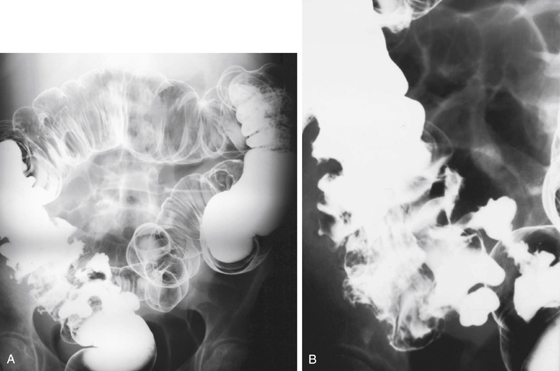CASE 197

History: A 27-year-old man from Turkey presents with abdominal pain and diarrhea.
1. What should be included in the differential diagnosis of the imaging finding shown in Figure A? (Choose all that apply.)
2. This patient had oral aphthous ulcers, skin lesions, uveitis, and genital ulcers. What is your favored diagnosis?
3. Why is Behçet’s disease known as the “silk route” disease?
A. The geographic distribution
B. Association with the silk industry
C. A disease affecting people of Eastern Chinese origin
D. Disease caused by use of illicit drugs trafficked along this route
4. What is the etiology of Behçet’s disease?
ANSWERS
CASE 197
Behçet’s Disease of the Colon
1. A, B, C, and D
2. B
3. A
4. B
References
Chung SY, Ha HK, Kim JH, et al: Radiologic findings of Behcet syndrome involving the gastrointestinal tract. Radiographics. 2001;21(4):911-924.
Cross-Reference
Gastrointestinal Imaging: THE REQUISITES, 3rd ed, p 300.
Comment
Behçet’s disease is a rare condition in the West, but is seen with more frequency as people move about the world. It is primarily a condition affecting the population living around the Mediterranean Sea, thought to have been brought back in the Middle Ages along the “silk route” pioneered by Marco Polo in his journey to China. A Turkish physician first described it in the literature in the 1930s, and the disease is known by his name. It affects several organ systems, including the eyes, skin, genitals, joints, and gastrointestinal (GI) system. The colon is almost always the GI organ involved, although cases of esophageal involvement have occurred. The most common site of colonic involvement appears to be the ileocecal region.
Behçet’s disease is essentially a vasculitis of unknown origin that leads to inflammation and ulcerative eruptions, often deep and severe, such as in this case (see figures). It may be easily confused with other inflammatory bowel diseases, especially Crohn’s disease. Patients usually have other manifestations of Behçet’s disease when colonic symptoms are present. Bowel perforations associated with Behçet’s disease have been reported. Occasionally, the disease may be seen as an ileocecal inflammatory mass similar to ileocecal phlegmon seen in Crohn’s disease.







